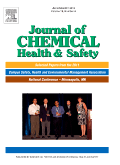
ACS Chemical Health & Safety
Scope & Guideline
Promoting excellence in chemical health and safety practices.
Introduction
Aims and Scopes
- Chemical Safety Education and Training:
The journal emphasizes the importance of educating students and professionals about chemical safety, including innovative training mechanisms and curriculum development. - Risk Assessment and Management:
A core focus is on methodologies for assessing and managing risks associated with chemical handling and laboratory practices, including the use of various analytical frameworks. - Emerging Technologies and Safety:
Research on the implications of new technologies, such as nanotechnology and AI, on safety practices in laboratories and industries is a significant area of interest. - Community Engagement and Safety Culture:
The journal explores the role of community involvement and the development of a safety culture within educational and industrial settings. - Accident Analysis and Lessons Learned:
A recurring theme is analyzing past incidents to extract lessons that can inform future safety protocols and prevent similar occurrences. - Chemical Exposure and Toxicity Studies:
The journal publishes studies on the toxicity of various chemicals and their safe handling, aiming to provide a comprehensive understanding of health risks. - Regulatory Compliance and Best Practices:
Articles often address compliance with safety regulations and the implementation of best practices in chemical management.
Trending and Emerging
- Integration of AI in Safety Practices:
The use of artificial intelligence to enhance safety practices and improve training methodologies is a growing area of interest, highlighting the intersection of technology and safety. - Focus on Mental Health and Safety Culture:
Emerging themes include the mental health aspect of safety culture, recognizing the psychological factors that influence safety compliance and behavior in laboratory settings. - Sustainability and Green Chemistry:
There is an increasing trend toward addressing sustainability in chemical practices, including the safe handling of environmentally friendly materials and waste management. - Community-Based Safety Initiatives:
Research focusing on community engagement in safety practices is gaining traction, emphasizing collaborative approaches to enhance safety culture. - Novel Materials and Safety Concerns:
With the rise of new materials, particularly nanomaterials, there is an increasing emphasis on understanding their safety implications and exposure risks. - Real-Time Monitoring and Risk Assessment Technologies:
Innovative approaches for real-time monitoring of chemical hazards and risks are emerging, reflecting the need for dynamic safety management in laboratories.
Declining or Waning
- Traditional Hazard Communication Methods:
There has been a noticeable decrease in papers focusing exclusively on conventional hazard communication methods, as newer technologies and approaches are gaining traction. - General Laboratory Safety Protocols:
The journal has shifted away from publishing generic laboratory safety protocols to more specific case studies and innovative practices that address current challenges. - Focus on Historical Perspectives:
While historical analyses have been important, there is a waning interest in papers that solely focus on historical safety practices, as the community seeks more forward-looking solutions. - Chemical Management in Non-Academic Settings:
Research related to chemical safety management in non-academic settings, such as industrial environments, seems to be receiving less attention compared to academic laboratory safety. - Single Chemical Studies:
There is a declining emphasis on studies that focus on the safety of single chemicals without considering broader applications or composite risks.
Similar Journals

Ovidius University Annals of Chemistry
Advancing Chemistry, One Article at a Time.Ovidius University Annals of Chemistry is a prominent open-access journal dedicated to the field of chemistry and chemical engineering, published by OVIDIUS UNIV PRESS since 2012. With its ISSN 1583-2430 and E-ISSN 2286-038X, this journal seeks to foster innovative research and disseminate knowledge across diverse chemical disciplines. Situated in the vibrant academic setting of Ovidius University in Constanta, Romania, this journal receives contributions from a global pool of researchers, enhancing its relevance in the international scientific community. The open-access format ensures that all published articles are freely available, promoting a wider reach and impact of the research dissemination. As a valued resource for academics, industry professionals, and students alike, the Ovidius University Annals of Chemistry plays a crucial role in advancing the understanding of chemical sciences and engineering practices.
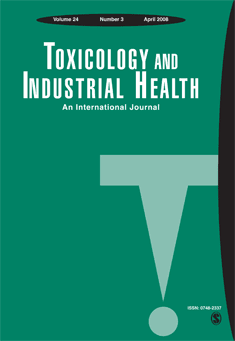
TOXICOLOGY AND INDUSTRIAL HEALTH
Fostering a safer tomorrow through comprehensive toxicology research.TOXICOLOGY AND INDUSTRIAL HEALTH, published by SAGE PUBLICATIONS INC, is a premier journal in the field of toxicology, public health, and environmental health, with a significant history dating back to 1985. With its ISSN 0748-2337 and E-ISSN 1477-0393, the journal provides a platform for disseminating groundbreaking research and comprehensive reviews that address the complexities of toxic substances in industrial and occupational settings. Despite its Q3 ranking among peers in health, toxicology, and public health, this journal is becoming increasingly influential, reflected in its growing citation metrics. Researchers and professionals benefit from its commitment to fostering knowledge in both theoretical and practical contexts, making it an essential resource for those dedicated to advancing understanding in this vital field. The journal's main objectives include promoting research addressing the implications of toxicology on health and safety standards across industries, ensuring accessibility to current studies for a global audience. Overall, TOXICOLOGY AND INDUSTRIAL HEALTH plays a critical role in bridging the gap between research and real-world applications, proving invaluable to students, professionals, and researchers alike in their pursuit of enhancing public health and environmental safety.
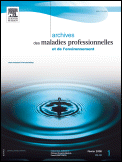
Archives des Maladies Professionnelles et de l Environnement
Fostering Dialogue on Health, Work, and EnvironmentArchives des Maladies Professionnelles et de l'Environnement is a vital scholarly journal published by Elsevier Science Inc, focusing on the critical intersections of public health, environmental issues, and occupational health. With an ISSN of 1775-8785 and an E-ISSN of 1778-4190, this French-based journal serves as a platform for researchers, professionals, and students to explore contemporary challenges and advancements in these essential fields. Although it holds a Q4 ranking in the 2023 Scopus quartiles, it provides a unique opportunity for new contributions that can drive future research directions. The journal accepts a variety of article types, with the aim of spreading knowledge that can influence policy and improve practices in occupational health and environmental safety. As we approach the convergence of its publication years from 2004 to 2024, the journal remains committed to fostering a comprehensive understanding of the impact of work and environmental exposure on health, making it an important resource for anyone invested in these disciplines.
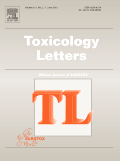
TOXICOLOGY LETTERS
Illuminating the path to safer chemical practices.TOXICOLOGY LETTERS is a prominent journal dedicated to advancing the field of toxicology, providing a platform for high-quality research and reviews that explore the effects of chemical substances on biological systems. Published by Elsevier Ireland Ltd, this peer-reviewed journal has established itself as a vital resource in toxicological research since its inception in 1977, with a convergence of studies extending to 2024. With an impressive Scopus ranking, positioned at #28 out of 133 in the Toxicology category, TOXICOLOGY LETTERS garners a respectable percentile of 79, highlighting its significance in the academic community. Although it is not an open-access journal, its research is accessible through institutional subscriptions, ensuring that critical insights into human health and environmental safety are disseminated effectively. Being categorized in the Q2 quartile in both Medicine (miscellaneous) and Toxicology for 2023 further emphasizes its relevance and impact in these fields. This journal aims to foster collaboration between researchers and professionals, encouraging the exploration of innovative solutions to chemical hazards and the promotion of safer practices in pharmacology and toxicology.
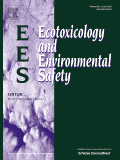
ECOTOXICOLOGY AND ENVIRONMENTAL SAFETY
Unraveling the complexities of environmental safety and toxicology.ECOTOXICOLOGY AND ENVIRONMENTAL SAFETY, published by Academic Press Inc. Elsevier Science, stands as a premier journal in the field of environmental science, specializing in the intricate relationships between toxic substances and ecological systems. With a commendable impact factor and recognized as a Q1 journal in various categories including Health, Toxicology and Mutagenesis, and Public Health, it consistently ranks among the top publications in Scopus, placing it in the 96th percentile for Medicine and Public Health. Established in 1977, this journal addresses critical issues related to environmental safety and pollution, making it an essential resource for researchers, professionals, and students alike. Although it does not offer an open access option, the journal’s commitment to publishing rigorous and impactful research makes it a vital platform for advancing the understanding of ecotoxicological risk assessments and environmental protection strategies. For those dedicated to the intersection of science and public health, ECOTOXICOLOGY AND ENVIRONMENTAL SAFETY serves as a beacon of knowledge and innovative research.
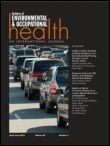
Archives of Environmental & Occupational Health
Elevating the discourse on toxicology and occupational safety.Archives of Environmental & Occupational Health is a prestigious journal published by Routledge Journals, Taylor & Francis Ltd, dedicated to advancing research and knowledge in the realms of environmental science, occupational health, and toxicology. With an ISSN of 1933-8244 and an E-ISSN of 2154-4700, this peer-reviewed journal has gained significant recognition, currently holding a Q2 ranking in Environmental Science and Q3 rankings in Health, Toxicology and Mutagenesis, and Public Health. Established in 2005, it serves as a vital platform for researchers, practitioners, and policymakers alike who aim to address and disseminate findings on pressing environmental and occupational health issues. The journal is not open access, allowing for rigorous peer review processes while still reaching a broad readership. As it converges through 2024, the Archives of Environmental & Occupational Health continues to play a critical role in shaping discourse and fostering innovation in the field, making it an essential resource for those committed to improving both human health and the environment.

ARCHIVES OF TOXICOLOGY
Elevating Standards in Toxicological ResearchARCHIVES OF TOXICOLOGY is a prestigious journal published by Springer Heidelberg, dedicated to advancing research in the field of toxicology and related disciplines. With a distinguished history dating back to 1930, this journal has continuously provided vital insights and groundbreaking studies, making it a cornerstone in the areas of health, toxicology, and medicine. Recognized for its high impact, it occupies a top-ranking position in Scopus, with remarkable quartile placements in 2023, categorizing it as Q1 in Health, Toxicology and Mutagenesis, and Q1 in Medicine (Miscellaneous). The journal highlights critical research and innovative methodologies, appealing to a diverse audience of researchers, professionals, and students committed to understanding the complexities of toxic substances and their implications for public health and environmental safety. The journal does not currently offer open access, allowing for a more traditional but rigorous peer-review process that ensures the quality and integrity of every published article. Join the global discourse in toxicological science with ARCHIVES OF TOXICOLOGY, where every contribution furthers the understanding of safety and toxicity in our world.
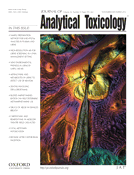
JOURNAL OF ANALYTICAL TOXICOLOGY
Empowering Safety Through Analytical ExcellenceJOURNAL OF ANALYTICAL TOXICOLOGY, published by Oxford University Press Inc, stands as a leading platform in the field of analytical chemistry and toxicology, focusing on the rigorous exploration of methodologies and advancements in the detection of toxic substances. Since its inception in 1977, this journal has continually contributed to the scientific community, providing researchers and professionals with vital insights into chemical health, safety, and environmental implications. With an impressive Q1 ranking in both Analytical Chemistry and Chemical Health and Safety, along with reputable Q2 rankings in Environmental Chemistry and Toxicology, the journal maintains its critical standing in vibrant academic communities, ensuring the dissemination of high-quality research. Although it currently does not offer open access, articles are made available via institutional subscriptions, allowing widespread access to its valuable findings. Located in the United States, the journal contains a wealth of knowledge poised to benefit scientists and scholars engaged in toxicological research, emphasizing its importance in enhancing public health and safety.
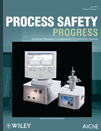
PROCESS SAFETY PROGRESS
Pioneering progress in chemical safety and reliability.PROCESS SAFETY PROGRESS is a distinguished journal published by WILEY, focusing on the critical intersections of chemical engineering and safety, risk, reliability, and quality. Established in 1993, this peer-reviewed journal serves as a significant platform for disseminating high-quality research findings and innovative solutions in process safety. With an established impact within its fields, it holds a Q3 categorization in both Chemical Engineering and Safety, Risk, Reliability and Quality as of 2023. The journal's rigorous manuscript evaluation process, combined with its emphasis on emerging challenges and solutions in industry practices, makes it a crucial resource for researchers, industry professionals, and students alike. Although not Open Access, PROCESS SAFETY PROGRESS continues to enhance its visibility through its indexed presence in Scopus, where it ranks in the 50th percentile in its categories. As it converges to its 2024 volume, the journal remains committed to promoting advancements in the field and fostering a safer environment in chemical process engineering.

JOURNAL OF APPLIED TOXICOLOGY
Advancing the Science of ToxicologyJOURNAL OF APPLIED TOXICOLOGY, published by Wiley, stands as a leading platform in the field of toxicology, focusing on the rigorous examination of chemical substances and their effects on biological systems. With an impressive Impact Factor, it ranks in the top quartile (Q2) for toxicology journals, reflecting its esteemed position within the scientific community. The journal, identifiable by its ISSN 0260-437X and E-ISSN 1099-1263, has been an invaluable resource since its inception in 1981, and it continues to serve as a conduit for innovative research and practical applications through 2024. Positioned at the forefront of the field, it garners recognition in the Scopus Rankings, where it ranks #31 out of 133 journals in the toxicology category, placing it in the 77th percentile—a testament to its contribution to the advancement of pharmacology and toxicological sciences. While not an open-access journal, it remains accessible to a wide audience of researchers, professionals, and students eager to explore cutting-edge findings in applied toxicology, making it a pivotal resource for enhancing knowledge and fostering collaboration in the field.